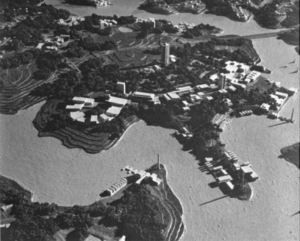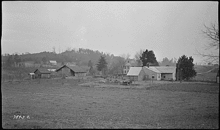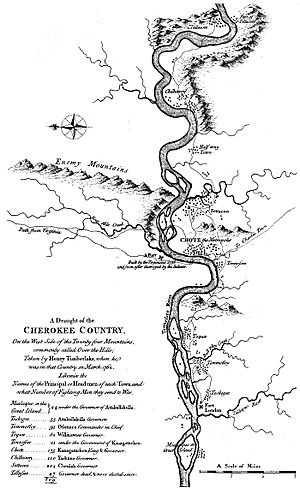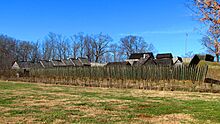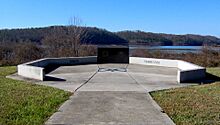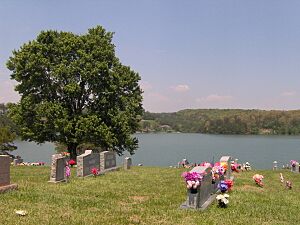Tellico Dam facts for kids
Quick facts for kids Tellico Dam |
|
|---|---|
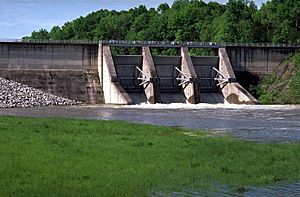
The main concrete gravity structure for Tellico Dam, pictured here in 2013.
|
|
| Official name | Tellico Dam |
| Location | Loudon County, Tennessee, U.S. near Lenoir City |
| Coordinates | 35°46′40″N 84°15′35″W / 35.77778°N 84.25972°W |
| Purpose | |
| Construction began | March 7, 1967 |
| Opening date | November 29, 1979 |
| Construction cost | $116 million (468 million in 2022 dollars ) |
| Dam and spillways | |
| Type of dam | Concrete gravity dam and earth embankment dam |
| Impounds | Little Tennessee River |
| Height | 129 ft (39 m) |
| Length | 3,238 ft (987 m) |
| Reservoir | |
| Creates | Tellico Reservoir |
| Total capacity | 467,600 acre⋅ft (576,800,000 m3) |
| Catchment area | 2,627 sq mi (6,800 km2) |
| Surface area | 14,200 acres (5,700 ha) |
The Tellico Dam is a large structure built on the Little Tennessee River in Loudon County, Tennessee. It was built by the Tennessee Valley Authority (TVA). Planning for this dam started as early as 1936, but it was not built until much later. The dam was finished in 1979. It created the Tellico Reservoir and was the last dam the TVA ever built.
Most TVA dams were built to make electricity or control floods. But the Tellico Dam was different. Its main goal was to help the local economy and bring in tourists. This was part of a plan to create a new, large planned city called Timberlake, Tennessee. The idea was to help a rural area with money problems by creating a city for 42,000 people.
The Tellico Dam project caused many arguments. People questioned if it was really needed and worried about its effects on the environment. Building the dam meant flooding thousands of acres of land. This land included farms that families had owned for generations. It also covered important historical sites. These sites included Fort Loudoun and several Cherokee tribal villages. One of these villages, Tanasi, is where Tennessee got its name. Much of the land around the new lake was later sold to private companies. They built retirement communities with golf courses, like Tellico Village.
The dam project also became very controversial because of a tiny, endangered fish called the snail darter. Groups that protect the environment took the TVA to court. They wanted to stop the project to save the snail darter. This court case stopped the dam's completion for more than two years. In 1978, the Supreme Court of the United States ruled that finishing the dam was against the law. However, the dam was still completed. The reservoir began filling in November 1979. This happened after the United States Congress and President Jimmy Carter passed a bill. This bill made the Tellico project exempt from the Endangered Species Act.
Contents
About the Tellico Dam Project
Early Ideas and the Timberlake Plan
The Tennessee Valley Authority (TVA) is a company owned by the U.S. government. It was created in 1933 as part of the New Deal programs. The TVA's first job was to modernize the Tennessee Valley region. This included improving electricity, controlling floods, and helping with economic problems.
In 1936, the TVA started looking for places to build dams for electricity. They thought about building a dam on the Little Tennessee River. This idea was put on hold in 1942 because of World War II. There was not enough money from the government.
In 1959, the TVA decided to move forward with the project. It was now called the Tellico Project. The main reason for it was to improve the economy of the Little Tennessee river area. This would happen through land and recreational development. The project included land in Loudon, Blount, and Monroe counties. It became known as the City of Timberlake Plan. It was named after a journalist, Henry Timberlake, who explored the Cherokee villages in the area.
The TVA hoped to build a new city from scratch with 42,000 people. The project was meant to show how to help poor rural areas. The Tellico Dam would create a large lake for fun activities. It would also allow boats to carry goods to new factories. These factories would connect to the Tennessee River through a canal. The dam itself would not make electricity. But the canal would help the nearby Fort Loudoun Dam make more power. The Timberlake project first had support from Congress and money from the Boeing Corporation. However, Boeing later decided the project would not make enough money and left in 1975. The city was never fully built.
Taking Land for the Dam
The Tellico Dam project needed almost 38,000 acres of land. The lake created by the dam would cover over 16,500 acres. Another 2,900 acres were for flood control. The TVA planned to use 16,500 acres for homes, recreation, and factories as part of the Timberlake city plan. The rest of the land would be a buffer zone around the lake.
When the TVA started to buy land, some communities were already quite modern. They did not like the TVA's plans as much as more rural communities did. Many TVA workers did not fully understand the local communities. This led to more strong opposition to the project.

The Tellico Project was first announced in 1960. In 1963, a group of landowners called the Fort Loudoun Association formed to oppose it. A large public meeting in 1964 showed strong opposition. Most of the 400 people there were against the dam. One month later, a bigger group, the Association for the Preservation of the Little Tennessee River, was formed. This showed that people would not easily give up their fight against the TVA.
The TVA used eminent domain to get the land. This is a legal right that allows the government to take private property for public use. Many landowners felt the TVA was overstepping its power. This made more people oppose the project. The TVA did not keep good records of how many families had to move. They first thought it was 600 families, but it was closer to 350. Three landowners who refused to move were forced out by U.S. Marshals. They watched their homes being torn down. The project also caused 330 farms along the Little Tennessee River to be lost. The TVA spent $25.5 million to buy all this land.
Building the Tellico Dam
The Tellico Dam was designed with a 600-foot-long, 129-foot-high concrete section that had flood gates. It also had a 2,500-foot-long earthen dam. An 850-foot-long, 500-foot-wide canal was built to connect the Tellico Reservoir to the Tennessee River. The Tellico Reservoir itself holds 467,600 acre-feet of water. It has a water surface area of 14,200 acres. Around the lake, about 23,600 acres were bought and prepared for future homes, businesses, and recreation.
Construction on the Tellico Project started on March 7, 1967. Workers began clearing land for the main dam. The concrete part of the dam was finished by October 1968. The earthen parts were done by August 1975. At this point, the river's flow was pumped through the dam's gates. By the time construction was stopped by court orders, the Tellico Project was almost 90% complete. Only some land clearing, recreational facilities, and a highway system were left to finish.
In total, $63 million was spent on building the dam. This included the concrete dam, earthen dam, roads, railroads, and the canal. Most of this money went to the dam itself and over 65 miles of new roads. The TVA also spent $3.6 million on two major road projects. One of these, the Tellico Parkway, was doubted by state officials.
The TVA made almost $665,000 from the project while it was being built. They earned $99,000 from selling timber cleared from the land. They also leased out seized farmland and houses, making about $566,000. The cost for workers on the project was $24.7 million. Engineering and planning services cost $14.7 million.
Environmental Concerns and Court Battles
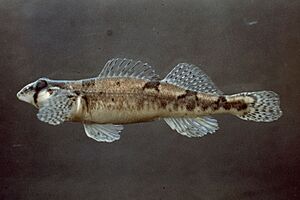
Even before construction, the Tennessee Fish and Game Commission warned the TVA. They worried that the dam would destroy trout fishing in the Little Tennessee River.
In 1963, the TVA tried to calm local anger by forming a group called the Little Tennessee River Valley Development Association. But this group could not stop the opposition. In 1964, the Tennessee Farm Bureau Association protested the dam. They said it would cause the loss of good farmland. A year later, the Cherokee Nation protested. They said the dam would flood their sacred ancestral lands. They sent a petition to President Lyndon B. Johnson.
In 1971, a professor from the University of Tennessee, Knoxville (UTK) criticized the TVA's plans. He said the TVA's cost and benefit studies were wrong. He also suggested that the TVA officials were not good enough at their jobs.
After many reports about the TVA's "abusive" land-taking methods, Governor Winfield Dunn asked the TVA to stop building the dam in 1971. He said the Little Tennessee River was too valuable to lose. The TVA refused his request.
In 1972, local farmers and environmentalists formed a group called the Environmental Defense Fund (EDF). The EDF sued the TVA. They said the TVA had not done an environmental impact statement (EIS), which was required by law. The TVA then showed an EIS they had completed. The case was dismissed, and construction continued.
The Discovery of the Snail Darter

On August 12, 1973, a group of students led by UTK biology professor David Etnier found something important. While snorkeling in the Little Tennessee River, they found several snail darters. Etnier said he "knew nobody had ever seen it before." Four months later, the Nixon administration passed the Endangered Species Act of 1973 (ESA). This law protected endangered species from harm to their homes. By this time, the dam was well under construction. Over $53 million had already been spent. On November 10, 1975, the snail darter was officially added to the Endangered Species list.
Fighting in Court to Protect the Snail Darter
To protect the snail darter, UTK law student Hiram "Hank" Hill and David Etnier filed a lawsuit. It was called Tennessee Valley Authority v. Hill. They said the TVA was breaking the ESA. A judge first allowed construction to continue in May 1976.
However, in January 1977, a higher court ordered construction to stop. The TVA then asked the U.S. Fish and Wildlife Service to remove the snail darter from the endangered list. This request was denied. In January 1978, the United States Department of Justice appealed the case to the Supreme Court of the United States. In a 6–3 vote, the Supreme Court agreed that construction should stop. They said the ESA clearly stated that habitats for endangered species should not be destroyed. The Court said the dam would "eradicate an endangered species."
After the Supreme Court Decision
After the Supreme Court ruling, a special committee was formed. It was called the "God Squad." This committee could decide to allow projects to go forward even if they harmed endangered species. But the committee refused to let the Tellico Dam project continue. They said that even though the dam was 95% finished, it was not worth completing.
A newspaper story reported that nearly 100 snail darters died during a move in 1977. The TVA tried to control the damage. They blamed the U.S. Fish and Wildlife Service for not using good enough nets.
President Carter's Involvement
After a long fight, Congress added a special rule to a public works bill. This rule made the Tellico Dam exempt from the Endangered Species Act. On September 25, 1979, President Jimmy Carter signed the bill. Carter had been against finishing the dam. But his advisors thought that if he vetoed the bill, Congress might block his other important plans.
Flooding of Cherokee Land
In 1979, some Cherokee people and groups sued the TVA. They wanted to stop the flooding of their sacred homeland. But they were not successful. Archeologists had surveyed and dug up some areas. This was because the area had many Cherokee towns from the 1700s. But the sites of Tanasi, Chota, Toqua, and other villages were all flooded by the new lake. Some of these sites had been lived on by Cherokee ancestors for up to 1,000 years. They had built large platform mounds there. Even older sites from the Archaic period were also flooded.
Other Impacts of the Dam
The town of Morganton and its port were covered by the Tellico Reservoir. The British colonial Fort Loudon was moved. Its original site was dug up and raised 17 feet. The fort was then rebuilt as a state park.
Moving the Snail Darters
Later, snail darters were moved from the Little Tennessee River to other streams. In total, 219 snail darters were taken from the Tellico area. Most were moved to the Hiwassee River in Polk County. They were doing well there by 1982. The Holston, French Broad, and Nolichucky rivers have also become homes for the snail darter.
Dam Completion and Recent History
The Tellico Reservoir began filling with water on November 29, 1979. This happened after the dam's gates were closed.
The TVA still wanted to develop the area to help the economy. They began selling land around the lake that they had taken using eminent domain. Many landowners who had lost their property could not afford to buy it back. This led to more arguments about property rights.
In 1982, the Tellico Reservoir Development Agency (TRDA) was created. It was funded by the state and the TVA. Its job was to help the Tellico region's economy. The TRDA helped create several industrial parks to attract businesses. This was meant to lower local unemployment. One area, the Tellico Peninsula, was supposed to be a prime development site. But it has mostly remained undeveloped.
Building Resort Communities
The idea for homes, which was part of the failed Timberlake project, was restarted in 1984. A company bought about 4,800 acres along the western shore of the Tellico Reservoir. This became a planned retirement community called Tellico Village. It officially opened in March 1986. The company promoted Tellico Village at golf and boat shows. Since then, the Tellico area has attracted many retirees, especially from the Midwest. This has led to a boom in real estate for retirement homes.
In the late 1990s and 2000s, private companies pressured the TVA to sell more land. This land had been taken by eminent domain around several lakes. They wanted to build more residential resorts, often with golf courses. In 1995, a 960-acre community called Rarity Bay was built. It included a horse riding center and a golf course. The developer of Rarity Bay built several other resorts on TVA land. He later faced legal issues in federal court.
In 2002, the TVA approved selling land on the eastern shore of Tellico Reservoir. This was for a large golf-course community called Rarity Pointe. In 2012, Rarity Pointe was bought by another company. They expanded the site and renamed it WindRiver.
The Snail Darter After the Dam
The snail darter was removed from the Endangered Species list on August 6, 1983. However, it was still listed as a threatened species. This was because the Hiwassee River, where many snail darters had been moved, had a history of acid spills from train accidents. By 2021, the snail darter was no longer considered threatened. The U.S. Fish & Wildlife Service reported that its population had recovered.
What We Learned from the Tellico Project
As of 2022, the Tellico Dam is still the last dam the TVA has built. Before the Tellico Project, building dams was almost always seen as a good thing. Dams were thought to represent progress and advanced technology. For much of the 20th century, the United States built thousands of dams. They were mainly for making electricity and controlling floods. By the 1950s, most good dam sites in the U.S. were already used. It became harder to justify new dam projects.
However, by the 1970s, the era of building many dams in the U.S. mostly ended. The Tellico Dam case showed how attitudes were changing. Many people now see the Tellico Dam project as an example of a "pork barrel" project. This means a project that is expensive and benefits a small group, rather than being truly needed.
From 1933 to 1979, the TVA forced over 125,000 people to move from their homes in the Tennessee Valley. This forced removal of people is still a debated topic. It raises questions about the TVA's methods and whether its dam projects were always right. In the 1980s, the TVA tried to build another dam for tourism and economic development. This was on the Duck River. But this project failed. The unfinished dam was torn down in 1999 because of environmental worries and rising costs. In 2001, the 13,000 acres set aside for that project were given to the state of Tennessee for public use.


